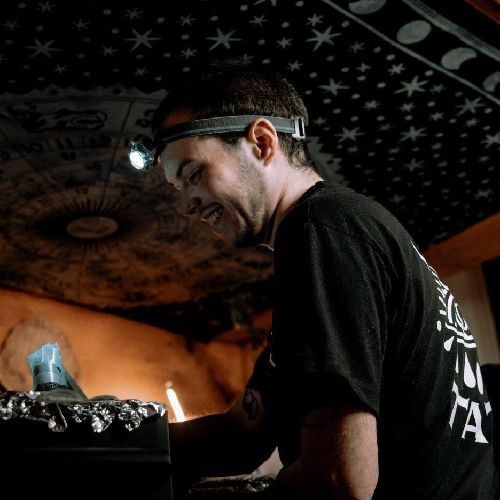
The Healing Art of Tattoos
By Loek Derks
My name is Loek Derks, 23 years old, trans man, and I have committed myself to helping the LGBTQIA+ community by offering an LGBTQIA+ inclusive and safe tattoo shop named Loek At Tatt. In addition to that I’ve done research on trans people and the therapeutic function of tattoos for my studies in art therapy and I give guest classes and lectures about gender and sexuality.
I would love to share my story with you: why I started a safe space tattoo shop, why a shop like that is so important and most of all, why tattoos are therapeutic!
How was Loek At Tatt created?
From my own experience I know how difficult it can be to find a tattoo shop that fully fits your needs and desires: both the style of the tattoo artist, the connection with the tattoo artist, as well as finding a pleasant space. A space where you feel at ease no matter your gender identity or sexuality. Through the years I’ve visited quite a number of tattoo shops and I’ve been tattooed by many artists. In doing so, I’ve noticed that by no means every tattoo shop is equally accepting or accessible. For example, some tattoo shops offered little to no privacy, there wasn’t always room for my own story or it was dismissed. In tattoo shops where multiple artists worked, I often noticed that the focus on me as a client was non-existent. I myself feel like it is actually really important that, when you’re getting a tattoo, you feel like there’s room for you to share your feelings with the artist if that is something you would like. It also quickly became clear to me that some tattoo shops prioritise people with specific body types or skin colours, especially when it came to posting photos on their social media.
These experiences made me think: why is it not self-evident that everyone, no matter their gender, sexuality, skin colour, background, et cetera, feels safe when they enter a tattoo shop?
Research by, among other people, Yuen and Thompson (2018) shows that many tattoo shops across the globe have a so-called ‘macho culture’. Even though there have been positive changes as well, these shops still often host a homophobic, racist, and sexist atmosphere, which makes them unsafe spaces for a lot of people.
For me what’s most important is that someone feels safe and at ease. This is why helping people has always been my priority, both in my work as during my studies. For example, my original plan was to go into healthcare, but after finishing my studies in social work my creative side kept itching. To combine my passions for working with people and art I decided to study art therapy. This is where I eventually discovered the overlaps between tattoos and art therapy. That’s when I knew I wanted to put my energy into that and now I’ve spent almost five years working to create a safe and pleasant environment for anyone who wants to get tattooed.
I find it incredibly rewarding to be able to give people a unique piece of art on their skin and to see what a difference I can make through this, by for example helping them find closure or celebrate a victory. In my opinion tattoos have a huge therapeutic function.
Emotions or feelings can be difficult to put into words, which is why it’s easier for a lot of people to express themselves through imagery. Using visualising materials like clay, paint, pencils and others it’s possible for conscious and subconscious thoughts and feelings to be expressed.
This image can be made into a permanent version by having it tattooed. These tattoos can stand for strength, process, loss, victory, or a new start.
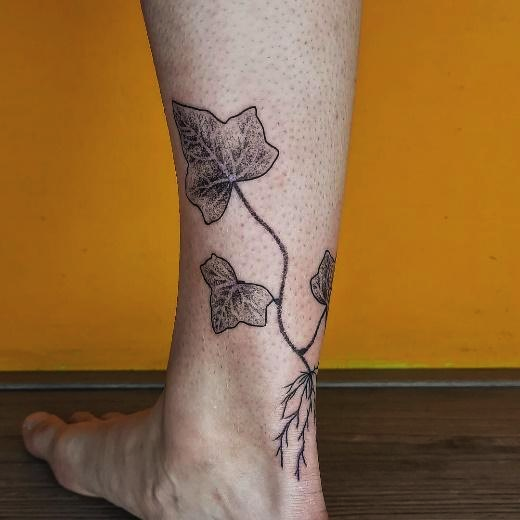
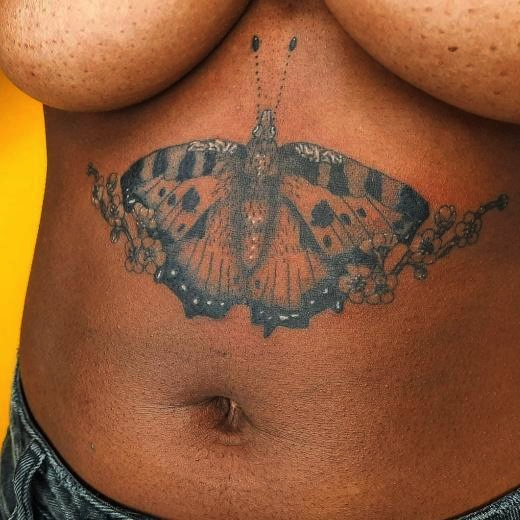
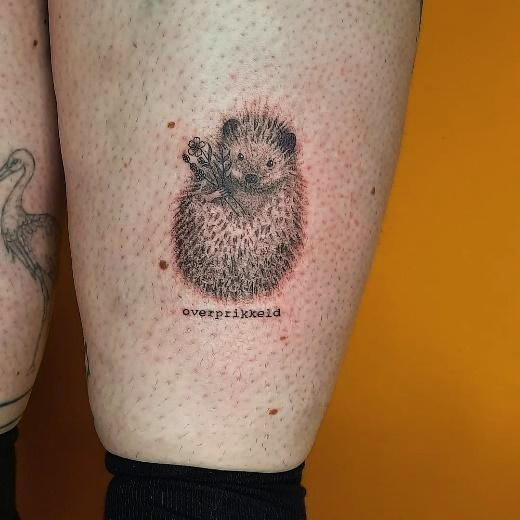
Research art therapy and tattoos
Many people get tattoos that have a specific meaning or story behind them, for example as a way to close a chapter in their lives, to process an impactful experience, during their mourning process, or as a victory and a new beginning.
During my own research, I found that tattoos can work therapeutically. This is because by getting a tattoo you actively take control of your body and how it looks. This creates new emotional strength that wasn’t there before the tattoo, which has a positive effect on your mood and self image.
Furthermore, it turns out that people who’ve had issues in their past related to problems with their mental health, illness, trauma, and other influential events experience a feeling of recovery after getting tattooed. They feel stronger in their sense of self and they can use the tattoo as an image of strength and motivation. For instance, I often get trans people in my shop who would really like to conclude their transition process with a tattoo, as a symbol for victory or to represent a piece of their life story. Additionally, there’s a lot of desire from trans people to get a tattoo during the waiting period of their transition as a way to keep a sense of control over their own body and to match their body more to how they feel and how they would like to look. This is therefore a good way to lessen dysphoria. It is not only as decoration, but also to improve your self image. The entire tattoo process is also a way to take some time for yourself and become aware of your own body. In doing so, the person uses the tattoo as a medium to feel more connected to their experiences or feelings.
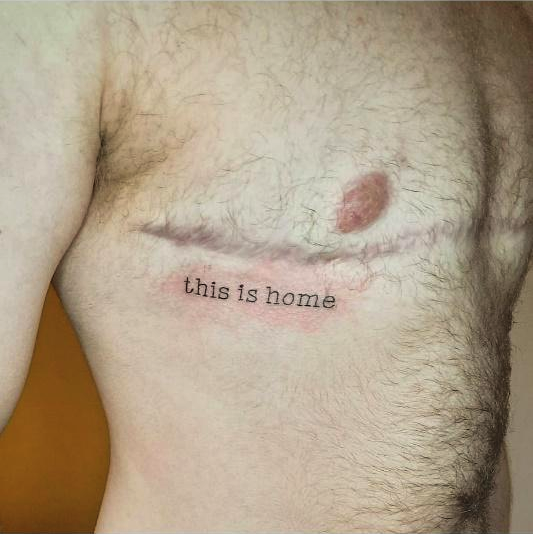
Om te vieren dat ik me nu thuis kan voelen in mijn lichaam.
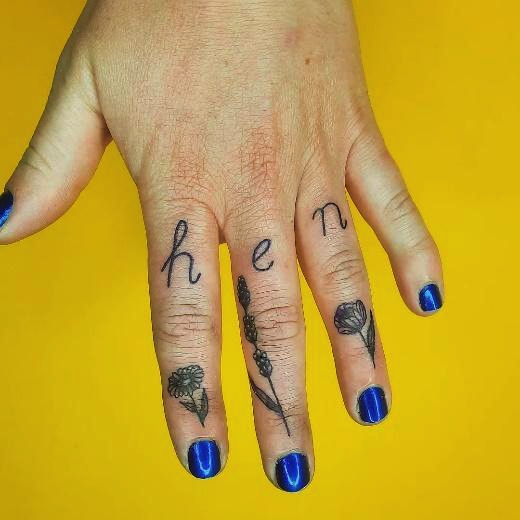
Ik hou van de natuur, want hen is non-binair, net zoals ik!

Why is a safe space important?
It’s important that you can be yourself and feel at ease wherever you are. In a tattoo shop this is especially important, as you’ll be adding something permanent to your body, which means you not only carry the tattoo with you forever, but also the experience as a whole.
You make yourself vulnerable, because you release the control over your own body. For this to be possible you have to be able to trust the tattoo artist. If you feel at ease with a tattoo artist, it’s a lot easier for you to guard your boundaries and express your wishes. For example, if you’re nervous and would like to take it easy, if you want to change the placement of the tattoo, or if you need to take a break. Furthermore, when you’re asked for your pronouns at the start of the session when the design is being discussed, there’s already less anxiety about the fact that someone might misgender you. These are all ways in which I try to put people at ease as a tattoo artist and try to treat them as they’d like to be treated. Because if people’s boundaries are being respected this way and there’s room for their needs, they’ll go into the session a lot more relaxed.
Another aspect that plays a big role when getting a tattoo for me personally is the amount of sensory input. I myself am quite sensitive to sensory input and when I’m in a big shop with a lot of artists, clients, loud music, and an environment that is unfamiliar to begin with, I can get sensory overloaded really quickly. This influences my experience enormously and that is why it’s so important to me that people with sensory issues are also able to go somewhere where they can be tattooed in peace. I also encourage my clients to regulate their sensory input themselves by using stim toys or by letting them pick their own music. That was something I would have liked to be able to do during my own tattoo appointments, and I noticed I was a lot less relaxed because I didn’t have these options.
On top of that, it can be difficult for people to feel at ease whose bodies don’t look completely normative according to the average Dutch standards (operations, weight, scars, etc.), partly due to the ignorance there still is in the tattoo world of less normative bodies. It’s happened multiple times to me that while getting a tattoo I was asked about my scars. When I explained this, I got a lot of intimate questions about myself and my transition while I didn’t feel comfortable at all to answer those. When you don’t feel at ease in a tattoo shop it can cause you to build up a lot of tension in your body and mind, and it might feel like your boundaries are being crossed. These kinds of feelings can have a negative influence on the entire tattoo experience and that’s exactly what I try to avoid as an artist. Because I’m very open as a tattoo artist about my own trans identity and know what kinds of questions or subjects can be difficult, clients can rest assured that their boundaries will be respected, but that there’s also an open atmosphere in which stories about transition, operations, and pronouns can be talked about in a low-key manner. The fact that not every tattoo shop offers this at the moment shows how important it is to create a low-key, accepting, and inclusive atmosphere in the shop.
What do I hope to achieve in the future?
I aim to clarify the connection between art, therapy, and tattoos and to make this more well-known to a wider audience. I hope that I can lessen the stigma on tattoos and the contemporary tattoo culture, and to be an example to other tattoo shops when it comes to inclusivity. By combining my passions for art therapy and art, I hope that people will start to see tattooing more like a form of therapy and that they’ll realise that tattoos can have importance to anyone, and can help people in their every-day lives.
Something that I’d like to change in the tattoo world of the future is changing the focus from the end result, which is the tattoo, to the whole experience, the story behind the tattoo, and the journey towards it. I want to create a better connection with a client by being more mindful of the development of the image and the story of that person.
Finally I’d like to show people that the whole tattoo process can be incredibly valuable and beautiful, instead of stressful or intimidating. When you’re not always seen for who you are, and you’re, for example, still on the waiting list of a gender clinic, you’re putting yourself in a very vulnerable position and this can become an obstacle when you want to go to a tattoo shop. This is a shame, of course, because a tattoo can actually help you a lot, both physically as mentally. Something I’d wish for anybody.
To the readers: what was your tattoo experience like? What would you have liked differently? Share it with us!
